Sailing A Catamaran
What are catamaran (dinghy) davits and why do you need them.
I keep hearing about davits on catamarans and after seeing a boat that was for sale with a broken davit (and missing its dinghy) I wanted to know more about them, so I did some research and learned a lot.
What are Catamaran Dinghy Davits and Why Do You Need Them? Catamaran davits are a set of crane like arms, typically fabricated out of stainless steel, mounted to the back of the sailboat between the transom steps, with the purpose to lift the dinghy with outboard up out of the water to secure it for sailing and also for security while at anchor. There are many different sizes, shapes and kinds of davits for catamarans.
Dinghy Davits on Catamarans (why you need them)
You don’t actually need dinghy davits but having properly engineered davits on your catamaran can make your life much more convenient and save you lots of headaches and money. You don’t absolutely need dinghy davits on a catamaran or sailboat. As I will explain later in this post, there are other, less convenience ways to lift your dinghy onboard. Other methods may also increase your personal risk of injury as moving around a dinghy and motor weighing several hundred pounds can be hard on your body and deck (and its just a lot of work).
Dinghy Theft Prevention
Dinghy theft is on the rise in many popular boating locations throughout the world. Keeping the dinghy in the water at night while you are sleeping and even during the day when you are not on the boat greatly increases your risk of having the dinghy or outboard motor stolen. For more about boating theft, noonsite.com provides an excellent free service of posting boating incidents throughout the world.
Why is a Good Dinghy Important?
The dinghy is like the family car for catamaran (and many other sailboat) owners. Unless you are spending all your time in a marina tied to a dock (and even sometimes when you are at a marina), you will need a way to get around. The dinghy allows you to drop the hook (anchor) and get to shore without having to swim. It is how cruisers go to the grocery store, explore islands, visit other boats, get to dive and snorkel locations, explore, walk the dog and get around without moving the entire boat off the mooring or anchorage. The more time you spend on your sailboat, the more important the size of the dinghy and the size of the outboard engine on the dinghy. The larger the dinghy, the more effort it takes to lift the dinghy in and out of the water. That’s where the davits come in.
Choosing the Right Size Dinghy
Choosing the best dinghy for your needs, boat and davit system is an important consideration. You want a dinghy that is large enough to fit your family and/or crew, carry your groceries, and family pet. You also want a motor that will allow you to get up on a plane when carrying the family and/or crew, groceries and pet. But (yes there is always a but), you don’t want to go too large that you outweigh your davit system.
Broken Davits Equal Lost Dinghys
I recently looked at a Lagoon Catamaran that was for sale. It had recently finished an Atlantic Ocean crossing. Not only was it missing one of its davits, but it was also missing its dinghy. I didn’t get all the details, but I can make an educated guess that either the dinghy was too large for the davit system or it wasn’t secured properly. I can also assume that the missing davit was the one on the outboard engine side of the dinghy (which holds most of the weight).
Which is First, Chicken (Davit) or Egg (Dinghy)?
If you are buying a used catamaran, then this decision may already be made for you, but if you need to purchase a new dinghy or both dinghy and davit system, then you need to think about engineering your davit prior to buying the dinghy. At least have an understanding of the limitations of each type of davit system and what it can hold. Buying too large of a dinghy or having undersized davits can be more than an inconvenience.
Important When Buying a Used Catamaran
Make sure your surveyor checks the davit system and provides information about the limitations of it. Many used catamarans have replaced a good dinghy with a smaller, cheap one. Don’t just think you can upgrade the dinghy without considering the davits. If you need to change both dinghy and davits it can set you back (cost you) tens of thousands of dollars, something you will want to upfront before purchasing.
Don’t Assume the Last Owner Did it Right!
When buying a used catamaran that has the perfect dinghy, don’t assume the last owner sized the davits correctly. Many used boats come out of charter and don’t experience rough seas from crossings or challenging passages. The charter companies restrict where they can sail to mostly calm seas. Once again, make your davit system is inspected by your surveyor for proper sizing, installation and any signs of stress.
Engineering the Davit System for the Dinghy
It is important to size the davits for the dinghy that it will be carrying. One common mistake is to take the overall weight of the dinghy and divide by the number of davits (two). So, if the overall weight of the dinghy is 400 pounds, the wrong way to size the davits is to carry 200 pounds each. Keep in mind that the outboard engine most likely will account for up to eighty percent of the weight of the dinghy so the davit carrying the engine side needs to be sized accordingly. Better yet, oversize both davits so that if the dinghy ever gets loaded in reverse or fills with water, it doesn’t get lost.
Properly Securing the Dinghy
Securing the dinghy to the davits is a critical step in maintaining the integrity of the davits. Going back to the example of the 400-pound overall dinghy weight, we can demonstrate how an unsecured dinghy can add a lot of stress to the davits. When the dinghy is secure it doesn’t move and generally, speaking the actual weight of the dinghy is what is transferred to the davits.
What Happens when it’s Not Secure (Fail)
When the dinghy isn’t secured properly and allowed to move around, additional weight and stress is transferred to the davits. Now imagine what happens to the dinghy when you are out at sea. Even in moderate seas, the dinghy is bouncing around and swaying back and forth adding not only downward pressure, but also side to side pressure to the davits. Over time (or the first time), this stress can cause a failure – a very expensive and potentially dangerous failure.
Boats Without Davits (Lifting the Dinghy)
So how do you lift the dinghy when there are no davits? There are a few ways to do it. Any sailboat with a boom can use it like a crane to lift the dinghy. Lift the outboard motor first, then the dinghy. This works great and is the way many smaller monohulls do it, though it does take a fair amount of effort. Of course, you can also lift it by hand, but you need strong crew in order to lift it this way and the chance of dropping it is increase. Some large catamarans have a dinghy garage and don’t need davits. Others have a large swim platform that raises and lowers to store the dinghy. If you are an experienced sailor and have seen or used another method, please share it in the comment section below (we would love to hear about it).
Towing Your Dinghy Behind Your Boat
You can tow your dinghy behind your catamaran. This isn’t recommended for long crossings or if you are expecting heavy seas and it may slow you down, but it is another way to move your dinghy. Of course, towing your dinghy doesn’t help with security while at anchor. You’ll have to think of another way to secure your dinghy and outboard when you are not using it.
How to Get the Dinghy in and Out of the Boat (With Davits)
Dinghy davits are one of the easiest and most convenient way for catamaran owners to raise and lower the dinghy in and out of the water. Rigged with pulleys and a winch, it is much easier than doing it by hand. There are many different davit systems, but generally this is how it works.
First, you connect the lines from the front davit to the front of the dinghy. Then you connect the lines from the rear davit to the dinghy. You can pull the lines manually or if equipped with a winch nearby, wrap around a winch and use it. The winch can be a hand crank or powered. Some systems are set up to lift the front and back of the dinghy at the same time with one line to the winch. For other systems, you may pull the front part way, then the back and back to the front, etc.
How to Drain Your Dinghy
Before pulling the dinghy all the way up, raise the front up higher than the rear. This allows you to drain any water (extra weight) that may be in the dinghy before securing. When all the water is out you may want to replace the plug in the dinghy (so you don’t forget before using) and finish raising both the front and the rear to their maximum positions. If it is raining or you are not going to be using the dinghy for a while, you may consider keeping the plug out so that the dinghy doesn’t fill up with water, which can add significant weight to the dinghy and stress on the davits.
Water Weight Can Add Significant Stress to the Davit System
Water weighs 8.33 pounds per gallon. Think about how much water your dinghy can hold, then do the math (Length of interior space X Width of interior space x 7.5 x 8.33 will get you close to the weight in pounds). Of course, if you need to collect water, keeping the plug in allows the dinghy to double as a water collection device. Just make sure that your davits are designed to hold the additional weight.
A Swinging Dinghy (My Favorite Band)
Yes, that title made me chuckle also. I think if I ever have a band, I would call it the Swinging Dinghys! A band by that name might even land a gig with Jimmy Buffet! Make sure the dinghy is all the way up to eliminate any extra force and stress that can be caused by a swinging dinghy. It may be a good idea to have an extra strap or two to tightly secure the dinghy to the davit or to the boat when sailing to keep if from moving. Rachet straps are a good idea for long passages. Remember a swinging dinghy can jeopardize the davit system (and your dinghy).
Man Overboard!
I have read about this happening to more than one person on the forums. The dinghy line comes loose and someone reaches out to pull the line tight just as a rogue wave hits the boat at a weird angle. In a split second, the person slips (or flips) overboard – hopefully noticed by someone onboard. A couple of points. Make sure you alert your captain and crew before attempting a fix so they are alert to what you are doing. If you are on a passage or in rough seas, it’s a good idea to have a safety line and/or PFD (i.e. life jacket) with EPIRB (beacon) so you can be found if you do go overboard.
Extra Padding
Depending on the davit system and type of catamaran, you may need to add padding on the davit to protect the dinghy when up and secure. The constant rubbing that occurs especially on long passages or crossings or in rough and choppy seas can harm your dinghy.
Custom Davit Systems
The davit system described in the above paragraph is one type, but there are many other types by OEM and custom aftermarket davit manufacturers. Many catamaran manufacturers use a davit system where the entire davit system (the stainless steel arms or frame) drops down towards the water. In this case, you clip each dinghy lines to the davit and lift the entire davit with one line through the winch. Both the front of the dinghy and rear of the dinghy and davit frame lifts at the same time.
Practical Davit Considerations
In addition to making sure the davit system is engineered to handle the weight of the dinghy (both actual and in motion) with consideration for the weight of the outboard motor, there are some other important things to look at.
First, make sure the dinghy fits the davit or the davit fits the dinghy. If not sized correctly, the motor may hit and rub on the davit. Next, consider how you are going to clip the dinghy to the davit. Will you be able to secure it in choppy seas? If you upgrade your dinghy, will your davits hold it. Very important to know before installing new davits and/or before buying a new dinghy. Davits are costly and so is a dinghy.
Catamaran Dinghy Davit Summary
Most catamaran owners will spend a considerable amount of time in their dinghy. It is a critical part of the catamaran sailing experience. It is therefore not only extremely important to have a dinghy that will fulfill your needs, but also to have a convenient way to store it. If you have the budget, invest in the best davit system you can buy as it will take away one challenge that comes with life on the high seas.
See you sailing!

Recent Content
Do You Need to Use Reef Safe Sunscreen when Snorkeling?
Do You Need to Worry About Pirates When Sailing?
MT370 Dinghy Davit
370lb capacity.

MT600 Dinghy Davit
600lb capacity.

MT600 EXT Dinghy Davit
600lb capacity, extended height.

Have questions or need more information?
Why martek davits.
- Our Davits come with an industry-leading two-year warranty!
- We work with customers during Davit selection to ensure proper fit and an installation that most can accomplish.
- We manufacture our Davits with polished, 0.12 wall thickness, 316 stainless steel tubing, and precision welded joints.
- Our mounting brackets are universal and will fit most applications.
- We can customize any part to fit the unique or challenging applications.
- We use the highest-quality parts and professional fabrication, assuring years of trouble-free performance.
- Most items are in stock and available for fast shipping.
If you need help configuring your Davits, please call or text us at (727) 412-1002 .
Installation Gallery
Martek Davits, LLC, 2024
- (727) 412-1002
- [email protected]

Service Locator
- Angler Endorsement
- Boat Towing Coverage
- Mechanical Breakdown
- Insurance Requirements in Mexico
- Agreed Hull Value
- Actual Cash Value
- Liability Only
- Insurance Payment Options
- Claims Information
- Towing Service Agreement
- Membership Plans
- Boat Show Tickets
- BoatUS Boats For Sale
- Membership Payment Options
- Consumer Affairs
- Boat Documentation Requirements
- Installation Instructions
- Shipping & Handling Information
- Contact Boat Lettering
- End User Agreement
- Frequently Asked Questions
- Vessel Documentation
- BoatUS Foundation
- Government Affairs
- Powercruisers
- Buying & Selling Advice
- Maintenance
- Tow Vehicles
- Make & Create
- Makeovers & Refitting
- Accessories
- Electronics
- Skills, Tips, Tools
- Spring Preparation
- Winterization
- Boaters’ Rights
- Environment & Clean Water
- Boat Safety
- Navigational Hazards
- Personal Safety
- Batteries & Onboard Power
- Motors, Engines, Propulsion
- Books & Movies
- Cockpit Confessions
- Communication & Etiquette
- Contests & Sweepstakes
- Colleges & Tech Schools
- Food, Drink, Entertainment
- New To Boating
- Travel & Destinations
- Watersports
- Anchors & Anchoring
- Boat Handling
Dealing With Dinghy Davits
Advertisement
If dinghy storage is lacking on your boat, the wide range of davits now available can offer a solution.
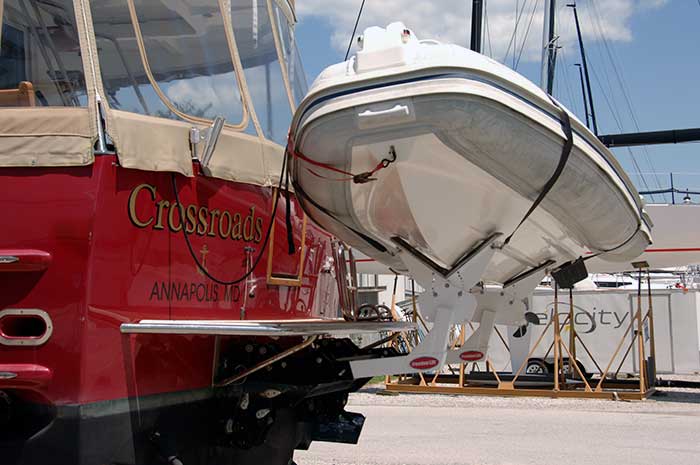
Photo: Bill Parlatore
When a boat is large enough for even the occasional overnight, the need for a dinghy becomes almost mandatory. But where do you put that all-important link to shore for lunch, dinner, shopping for supplies, walking the dog, seeing the sights, exploring the shoreline, or visiting neighboring boats? Fortunately, when it comes to davits, we have many choices to suit needs and budgets. Considering the variables when comparing davit systems, and finding the best system may take some research, but there are solutions to fit every boat. The goal is to find the one that works best for your boat and makes your day on the water easy and fun.
Whether you have an express cruiser, trawler, sport cruiser, picnic boat, or other style of craft, before you jump in, make a realistic assessment of your dinghy because its size, weight, and that of its outboard will have a significant impact on davit choices. While a large rigid inflatable boat (RIB) with a 50-hp outboard might be great fun on the family vacation, there are likely serious limitations for a davit system to fit such a boat. Dinghy size and weight may impact trim, performance, and the structural integrity of your mother ship. While some boat owners get around this by towing their large dinghy, it's not a safe or practical solution for anything more than a short hop from one anchorage to another. TowBoatUS and the BoatUS Marine Insurance Program get dozens of calls each year after a towed dinghy has done damage to itself or the boat towing it.
Keith Olver of davit manufacturer KATO Marine says the question of what dinghy you want comes with an important caveat. "It's harder for us to design for what owners want, rather than selecting a dinghy for what is possible." If you've already got a dinghy, you may be able to build a system to fit it. If not, the next step is to find a system that works for your boat type, knowing that the system you choose will box in the size and weight of the dinghy.
Traditional Davit Arms
Davit arms work best on boats with vertical transoms or sterns with railings strong enough to be the basis of support for the davit arms, such as a lobster boat or trawler-style cruiser. The arms mount onto the top of the transom and extend out behind the boat, clearing the swim platform, if there is one. Additional bracing of the transom area is sometimes required to reinforce the hull from the shock loading of a bouncing dinghy in rough weather.
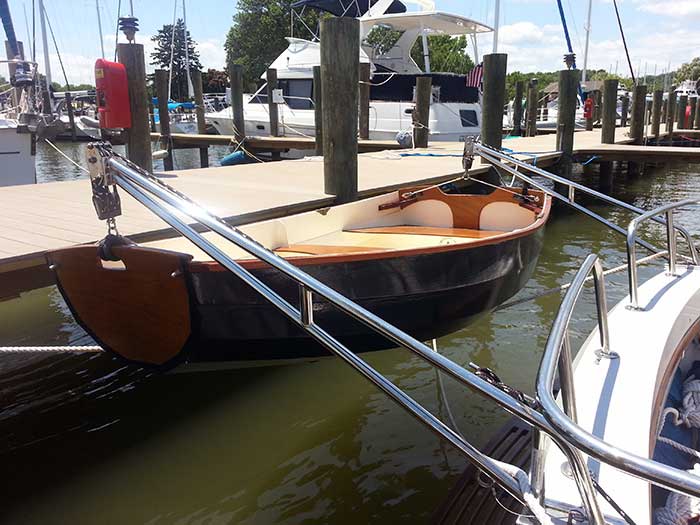
Traditional davit arms offer a reliable solution, but the dinghy does block access to the swim platform. (Photo: Joe Marin)
Weight is important when planning a traditional davit-hanging system. Selecting a pair of davit arms each rated for a maximum of 300 pounds doesn't mean it's safe to carry a 600-pound dinghy. Up to 75 percent of the total weight of the dinghy and outboard is in the stern. So one davit arm will always be loaded much more heavily than the other and may need to be reinforced if there's any question of its ultimate integrity.
Other configurations attach the davit arms directly to the stern rail with additional bracing to strengthen the railing support. Olver says it's essential to strengthen the stern rail to handle the increased weight of the dinghy hanging from the davit. It's also important to stabilize the davit arms so they can't move from side to side as the boat moves. This lateral support is often done by connecting the davit arms with rigid support between the two.
The dinghy must be stabilized to prevent motion when stored. The weight of gravity pulling the dinghy down becomes a compound set of forces when the boat is moving, and every effort must be made to steady and eliminate all movement. Most davit systems that fail do so because the dinghy was allowed to swing underway, or it comes loose, and the combination of side-to-side and up-and-down movements creates complex loads beyond the engineered capacity of the davit system. The twin-davit-arm system is a proven approach for handling the dinghy and has much to recommend it. Some companies offer removable arms that can be taken off and stowed when necessary, such as those from St. Croix Marine.
Swing-Up/Snap Davits
Another system that's been around for a long time was pioneered by Weaver Industries. Called the Weaver Snap Davits, the system involves attaching connecting hardware to both the dinghy and swim platform. The dinghy fittings snap into those on the swim platform and you pull the dinghy up vertically onto the swim platform, either manually or electrically, and secure it in a near-vertical position with standoff brackets or ties. St. Croix Marine Products and Sea Wise Marine are manufacturers of similar systems, and an optional hydraulic operation is even offered.

Swing-up or snap davits are easy to install yourself, and work best with light inflatables powered by small outboards.
Most dinghy installations require the removal of the outboard engine from the dinghy, although these companies have optional equipment that can be added to allow the outboard to remain on the dinghy and swivel as the dinghy swings up. Using a smaller and lighter outboard might make sense for this system if you intend to remove the engine each time the dinghy is secured.
Snap davits are popular with owners of smaller boats that have a swim platform, or on boats with large cockpits, such as the picnic-style powerboat or express cruiser, where it's about the only way to carry a dinghy. These are generally good do-it-yourself install projects and relatively inexpensive.
As popular as these swing-up systems are, I find it frustrating to overtake a boat when its dinghy is carried vertically on the swim platform, covering the boat's name and hailing port and making that VHF call for a portside pass challenging. Some boat owners paint the boat's name on the bottom of the dinghy for this reason. Rear visibility from some helms can be an issue when the dinghy is vertical on the swim platform, and, of course, using the swim platform is harder when a dinghy is stored on it. If you choose one of these systems, make sure the dinghy will not obscure your stern light when stowed.
Pull-Up, Slide-Up Davits
These davit systems offer a low-tech approach to handling the dinghy. The pull- or slide-up davits have two hinged cradle arms mounted onto the swim platform. When you want to get the dinghy aboard, the hinged arms tilt out to the water from the swim platform, and you pull the dinghy sideways onto the cradle arms.

Pull- or slide-up davits work best on boats with wider swim platforms, and allow you to leave the outboard in place.
As the center of weight comes aboard, the hinged arms come back to rest on the swim platform and the dinghy is then secured with straps on the swim platform. The outboard doesn't have to be removed. These davits can be used on most swim platforms wider than 18 inches and work best if the top of the swim platform is relatively close to the water. If the platform is too high, it can be difficult to manually pull a dinghy aboard. An electric winch can be used to accomplish this on some vessels.
Lifting Platforms
I recently spoke with Steve Wallace, manager of Zimmerman Marine at Southport Marina n North Carolina. His facility is located along the Intracoastal Waterway in a town that is a safe haven from the ocean, giving Steve the opportunity to talk to many hundreds of cruisers passing through Southport. "The key to happiness is ease of use," Steve said. "Boaters want to push a button and just go."
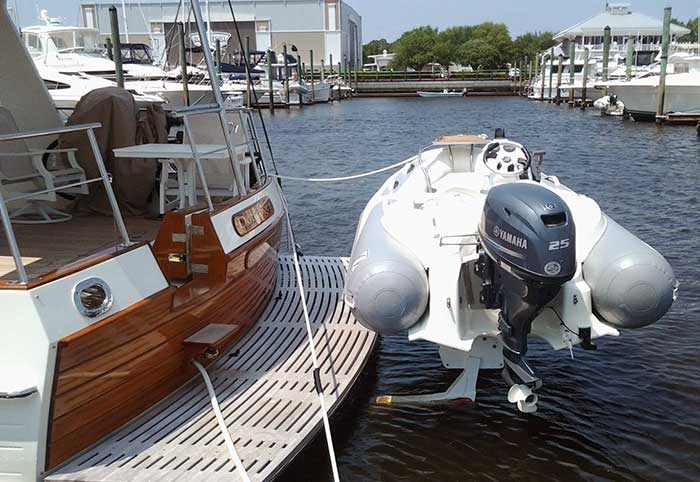
Hydraulic lifting arms and platforms are convenient but expensive.
Hydraulic and electric platforms with cradles have really come into their own in the last decade, especially with electronic controls and refined engineering. The concept of a lifting swim platform or cradle really resonates with powerboat owners no longer wanting traditional block-and-tackle systems. These hydraulic lifts can handle much greater weight, and you can opt for some form of sport boat instead of a traditional inflatable dinghy, while retaining easy launch and retrieve capability using a remote. As you might imagine, installing a lifting swim platform is best done during construction. One can be added as an aftermarket project, but it depends on the boat. That is perhaps why more builders offer a lifting swim platform as an option on a new boat when access is best before steering, exhaust, and machinery systems go in.
Lifting Cranes
If the cost of a lifting platform is beyond reach, or it can't easily be retrofitted to an existing boat, a lifting crane may be an option, using hydraulic, electric, pneumatic, or manual power.
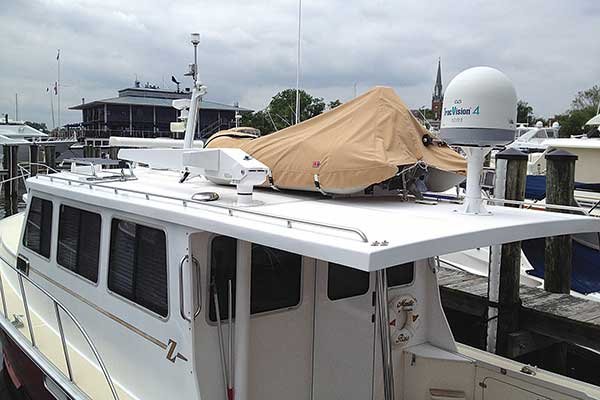
Lifting cranes can help you store your dinghy up on the flybridge or hardtop out of the way, reducing the chance of theft or damage, but usually require significant structural reinforcement during installation.
A standpipe is installed in the boat, firmly attached to the hull and deck structure, and a telescoping crane fits into it. The crane lifts the dinghy off its cradle, and the boom swings out over the side of the boat to lower the dinghy into the water. Lifting cranes used to be seen only on very large yachts, but now they can be found on boats under 40 feet.
- Weaver Marine Products
- St. Croix Marine Products
- Kato Marine
- Hurley Marine
- FreedomLift
- Trick Davit
- Atkins & Hoyle, Ltd.
- Olsson Mfg.
- LaConner Maritime Service
- Sea Wise Marine
Related Articles
The truth about ceramic coatings for boats.
Our editor investigates the marketing claims of consumer-grade ceramic coatings.
Fine-Tune Your Side Scan Fishfinder
Take your side-scanning fishfinder off auto mode, and you’ll be spotting your prey from afar in no time
DIY Boat Foam Decking
Closed-cell foam flooring helps make boating more comfortable. Here’s how to install it on your vessel
Click to explore related articles
Bill Parlatore
Contributor, BoatUS Magazine
Bill Parlatore is the founding editor of PassageMaker magazine with his wife, Laurene.
BoatUS Magazine Is A Benefit Of BoatUS Membership
Membership Benefits Include:
Subscription to the print version of BoatUS Magazine
4% back on purchases from West Marine stores or online at WestMarine.com
Discounts on fuel, transient slips, repairs and more at over 1,200 businesses
Deals on cruises, charters, car rentals, hotel stays and more…
All for only $25/year!
We use cookies to enhance your visit to our website and to improve your experience. By continuing to use our website, you’re agreeing to our cookie policy.
- The magazine
Current issue
- All the issues
- My magazines
- Technical specifications
- Multihull of the Year
- Classified Ads
- Destinations
- Online store
- All the magazines
- Subscriptions
- Accessories

Davits and arches : Getting your dinghy back aboard your multihull
The dinghy is the one piece of equipment you use at every port of call, meaning 70% of the time while you’re cruising. But what about launching it and getting it back on board? We take a look at the systems available.
Create a notification for Technical
We will keep you posted on new articles on this subject.
Published 25/01/2020
By Olivier Barret
Published: mar. / apr. 2020

Choose the option that suits you best!
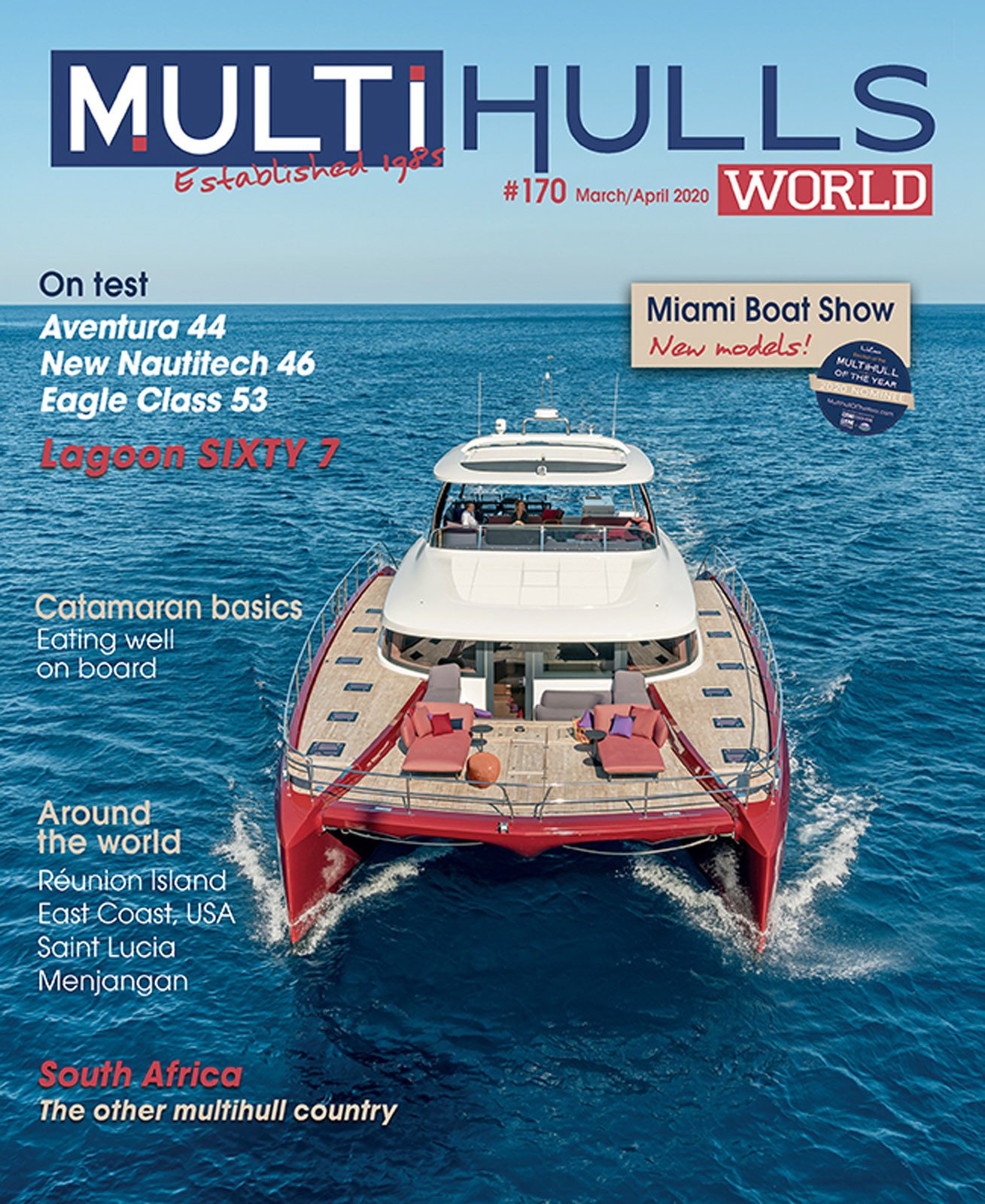
Issue #: 170
Published: March / April 2020
- Price per issue - digital : 6.20€ Digital magazine
- Price per issue - print : 8.50€ Print magazine
- Access to Multihulls World digital archives Digital archives
Advantage catamarans
Launching and raising the dinghy is generally a daily operation, sometimes even more frequent than that. Taking the dinghy out of the water improves performance under sail - or limits fuel consumption. It's also the best way to avoid having it stolen during the night... Given the frequency of handling, you should really have a decent system, to avoid lumbago or other back problems. With their large beam, multihulls and especially catamarans, offer the best solution for “ready-to-go” stowage of a decent-size tender. It’s not uncommon to see dinghies over 3 meters (10’) long on catamarans of around 40 feet. But it’d be a different story on a monohull, even if you were to fully deflate the dinghy. If we rule out storing it on the trampoline (always an option, though) and launching it with the spinnaker halyard (only valid for small tenders), there are several ways of storing it at the transom. Davits are the most common system, but the proliferation of aft bathing platforms is a recent boon for our tenders. Another possibility, often used by monohulls but now regularly seen on board our multihulls, is the arch. And, finally, the most extreme option: the hydraulic passerelle or crane, which is often seen on multiyachts.
This is the simplest and most effective way to lift your dinghy without too much effort. If your multihull isn’t already equipped with any, stainless steel models are available from chandleries from around € 300 per pair. However, these low-priced models won’t support a load much higher than 50 kg (110 lbs), which drastically limits the size of your tender. For a 3.50-meter (11½ foot) dinghy, you can expect a load of 150 kg (330 lbs) including outboard and fuel. For those who don't like the prominent design of these spars, there are telescopic models which retract under the transom gunwale. By fitting a set of blocks, the hoisting lines can be brought back to a winch: the mainsheet winch, for example. For performance enthusiasts who don’t want to add too much weight aft, some manufacturers offer models in polyester composite and even carbon.
A cradle on the platform
These days, many catamarans are equipped with optional bathing platforms. Whether they’re hydraulically or manually operated with a winch, they allow the tender to be launched very easily by lowering the platform below sea level. You’ll still need to install a cradle and lashing points to hold the dinghy securely. Cradles or chocks are available in stainless steel or composite; they can be retractable in order to limit the risk of getting your feet caught in them and enjoy the bathing platform. This arrangement is very suitable for a much heavier dinghy: hydraulic platforms can support up to 600 kg (1,300 lbs) and more. If your multihull is not equipped with an original platform, it is possible to fit one on the transom. Yard-mounted models are quite wide and heavy; there are smaller and lighter ones suitable for small boats or ...
Subscribe to Multihulls World and get exclusive benefits.
Most-read articles in the same category

Drivetrains
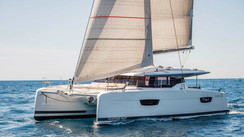
Bending on sails
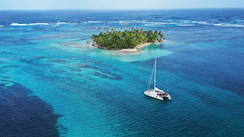
Everything you need to know about trampolines
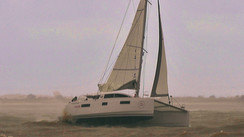
Managing heavy weather in a multihull
What readers think.
Post a comment
No comments to show.
MW #197 - Oct / Nov 2024
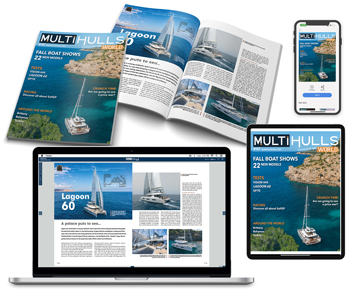
Tenders with two hulls...

Hydrogen on board
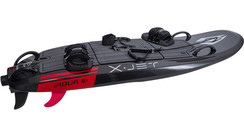
X-Jet Extreme iAQUA
Subscribe now.
The latest news from €3 / month
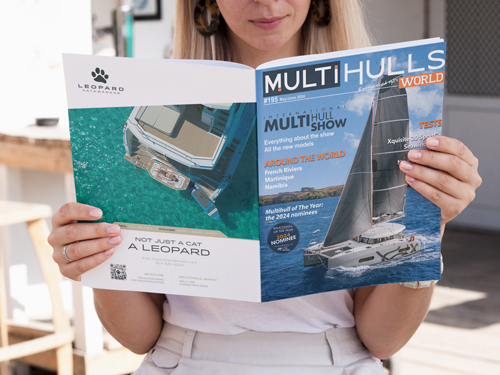
Video of the month
Our latest YouTube hit!

The Multihull of the Year
The 2024 results

Classified ads

Catamaran ORC 42 n°20
2020 Fountaine Pajot MY6 (ex MY44)

Solid and fast catamaran
Catamaran Lagoon 470 et sa société de commercialisation
Vous avez ajouté " " à vos favoris., vous avez supprimé " " de vos favoris., in order to add this article to your favorites, please sign in..

Dinghy Davits
FREEDOM TO EXPLORE We offer simple, high-quality solutions to your dinghy and Sea-doo storage needs.
The Problem
For avid boaters, a dinghy is almost mandatory! Especially on longer, overnight voyages. The luxury and convenience of having your dinghy inflated, clean and ready to use is second-to-none. BUT how do you take your dinghy along for the ride without losing precious deck space or possibly breaking some toes?
The Solution
We have created high-quality and easy-to-install Dinghy Davits to put your mind at ease allowing you to enjoy the open waters and soak up the good times. Our sophisticated boating community is always looking for creative, elegant and functional solutions for dinghy or Sea-Doo storage. Our davits systems are simple to set up and easily hide away when not in use, saving both your amazing deck space as well as your toes!
What the people are saying
Simply surpassed all expectations! First, the client experience, wow: They pick up the phone (no silly phone system), they're knowledgeable and down to earth friendly. Then it's on with quick shipping (only a few days). Lastly, the quality of the material? Omg, this extended davits system is made thick and solid, like, rocket grade and it made me grin: "Ohhh yeah!" It all just feels so right to purchase those quality davits for the 340 Sea Ray Sundancer.
I can't say enough of the excellent after sales service of this company! Incredibly responsive and the product quality is top notch. I had questions during the install and leading up to the purchase and the company answered my calls every time, regardless of when. Truly impressive customer service.
The Drop Down Davits are very well made and take up very little space when not in use which is great!
Featured Products
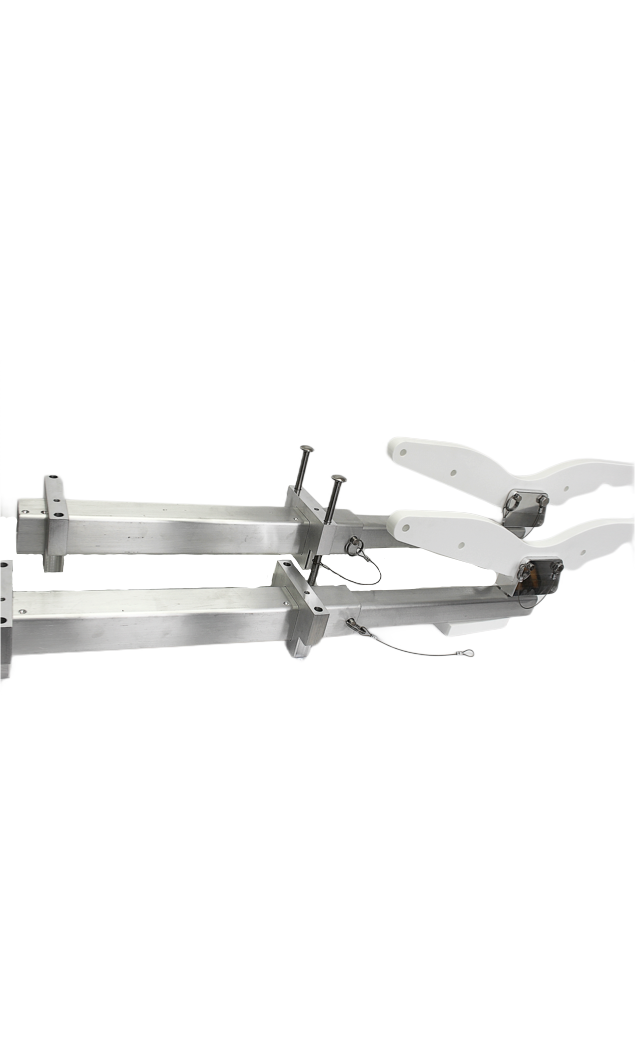
Under Mount Extended Davit
$1,200.00 usd.
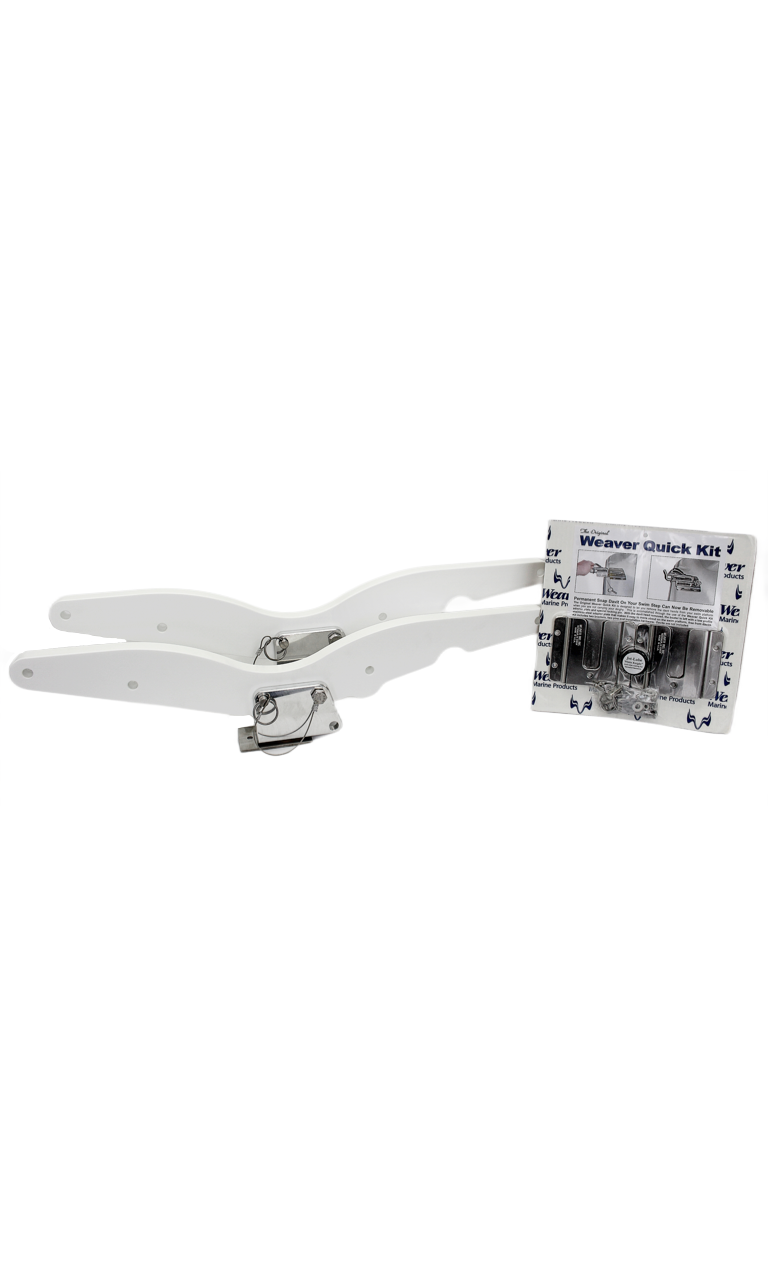
Top Mount Davit
$900.00 usd, connect with us.


Have a question?
We’d love to help you find the best solution for your needs!
© Copyright 2021, Dinghy Davits. All Rights Reserved. This website was brought to you by LaunchPad Creative Inc .

WORLD CLASS DAVIT SYSTEMS
1 800 883 2848.
Welcome to Ocean Marine Systems. We produce high quality marine stainless steel precision welded Davit systems.
We are proud of the world-wide record of performance that our dinghy davit systems deliver year after year as well as our outstanding record of product engineering, quality, technical support, customer service and the “beyond the call of duty” reputation we have established with our clients over the years.


Hurley H3O Dinghy Davit System
$ 2,889.95 – $ 3,489.95
Currency Calculator
Hurley H3O Dinghy Davit System ® (Hurley’s 3rd Option) . . . the Hottest Dinghy Davits on the market!
The rugged Hurley H3O Dinghy Davit System lets you winch your dinghy on for easy storage or just push-off for launching.
- CAD design software was used throughout the product development cycle of this complex design yet simple for easy use.
- Impressive combination of design and function with superior quality & craftsmanship.
- Universal linear bunk design to fit a multitude of hull designs.
- Made of Marine Grade High-Density Polyethylene for strength and to reduce friction during retrieval and launching.
- Ideal for high swim platforms, docks and/or heavy tenders.
- Our revolutionary new stainless steel mounting system provides a quick release, leaving a very small footprint profile that could pull a barge.
- Easily mounted on the swim platform and can be installed while the vessel is in the water, in most cases.
- Made in the U.S.A.
- Braking Hand Winch included. Electric winch available.
- 3′ to 5’ adjustable and removable winch arm.
- Overall weight: 53 pounds (24.04 kg)
- 400 pounds (181.43 kg) capacity.
- H3O Davit Extension available.
If you need more room on your platform for your tender, add a Davit Extension .
Review our Recommended Tie-Down Method
Ask about our special Highfield Dinghy Davit Inserts .
⚓️ Shop for “H3O Accessories”
- Description
Additional Information
- Davit Worksheet
- Reviews (12)
Hurley H3O Dinghy Davit System ®
The Hurley H3O Dinghy Davit System ® is specifically designed to allow the safe retrieval and stowage of a rib dinghy / hard-hulled tender, using the linear bunk system for on your boat or dock. The H3O Dinghy Davit ® has an adjustable and removable winching system. The stainless steel retrieval arm is adjustable from 3' to 5', depending upon the length of your tender. Easily removed for storage while underway. The H3O Dinghy Davit is ideal for tenders up to 10'6" (3.23m) long and not more than 400 pounds (181.43 kg) capacity. A davit extension is available for smaller platforms.
The system has two small stainless steel mount plates that requires only a total of four bolts for the install and only stands 5/8" high ( 2 included). This mounting system provides a quick release leaving a clear deck for any activity. Mount Covers are available. Easily mounted on the swim platform, these hassle-free systems let you winch your dinghy on for easy storage or just push-off for launching. Always available in an emergency.
In order for the H3O Dinghy Davit® to work for you, your platform will need to have the workable depth (transom to swim platform edge) of at least half of the beam of your tender, or more. It's all dependant upon tender weight, as well as other configurations of your vessel. Give us a hail or fill-out our Davit Worksheet to let us help you figure it all out! Make Sure it says " HURLEY " . . . Made in Michigan, Sold Globally!
Featured in the Miami International Boat Show "Innovation Award Program" Featured in the "Product Showcase" of the Miami International Boat Show Featured in the METS (Marine Equipment Trade Show) in Amsterdam, Netherlands
H3O Purchase includes: H30 Dinghy Davit®, Braking Winch with Retractable Arm and Mounts. Mounting bolts are not included . Shipping weight 53 pounds.
• Two Year Warranty on the davit and 90 days on the winch.
Fill-out our Davit Worksheet to help us determine if the H3O will work for you.
H3O Instruction Manual » H3O Mounting Template » H3O Extension Instructions » H3O Electric Winch Instructions » H3O Electric Winch Assembly » Dinghy Davit Gallery »
| Weight | 53 lbs |
|---|---|
| Dimensions | 37 × 13 × 8 in |
| Select Davit Model | H3O w/ Hand Winch – $2,889.95, H3O w/ Electric Winch – $3,489.95, Black H3O w/ Hand Winch – $2,889.95, Black H3O w/ Electric Winch – $3,489.95 |
In order for the H3O to work for you your platform will need to be at least 30″+ in depth (transom to swim platform edge) as well as other configuation measurements of your vessel and dinghy. Give us a gail to let us help you figure it all out!.
Davit Worksheet - How to Measure for a Dinghy Davit
Boat & platform info.

- (A) Swim Platform Internal Width
- (B) Swim Platform Depth Measurement from Transom to Edge of Swim Platform.
- (C) Distance from Top of Platform to Water
- (D) Transom Height Distance from Top of Platform to the Top of your Transom.
- Obstructions on Platform? If so, please describe and make sure that you also upload photos. (see below)
- Year, Make, Length & Beam of Main Vessel
Dinghy Info
- Make of Dinghy
- Beam of Dinghy
- Length of Dinghy
- Soft Bottom
- Hard Bottom
- Total Dinghy Wet Weight (with engine)
- Upload photo #1 - max 6mb (megabyte) Pictures help! Submit an image or two of your swim platform here. Accepted file types: jpg, gif, png, pdf, Max. file size: 6 MB.
- Upload photo #2 - max 6mb (megabyte) Submit another image. Accepted file types: jpg, gif, png, pdf, Max. file size: 6 MB.
- Upload photo #3 - max 6mb (megabyte) Submit another image. Accepted file types: jpg, gif, png, pdf, Max. file size: 6 MB.
- Name (required) * First Last
- Email (valid email is required) * Enter Email Confirm Email
- Address Street Address Address Line 2 City State / Province / Region ZIP / Postal Code Afghanistan Albania Algeria American Samoa Andorra Angola Anguilla Antarctica Antigua and Barbuda Argentina Armenia Aruba Australia Austria Azerbaijan Bahamas Bahrain Bangladesh Barbados Belarus Belgium Belize Benin Bermuda Bhutan Bolivia Bonaire, Sint Eustatius and Saba Bosnia and Herzegovina Botswana Bouvet Island Brazil British Indian Ocean Territory Brunei Darussalam Bulgaria Burkina Faso Burundi Cabo Verde Cambodia Cameroon Canada Cayman Islands Central African Republic Chad Chile China Christmas Island Cocos Islands Colombia Comoros Congo Congo, Democratic Republic of the Cook Islands Costa Rica Croatia Cuba Curaçao Cyprus Czechia Côte d'Ivoire Denmark Djibouti Dominica Dominican Republic Ecuador Egypt El Salvador Equatorial Guinea Eritrea Estonia Eswatini Ethiopia Falkland Islands Faroe Islands Fiji Finland France French Guiana French Polynesia French Southern Territories Gabon Gambia Georgia Germany Ghana Gibraltar Greece Greenland Grenada Guadeloupe Guam Guatemala Guernsey Guinea Guinea-Bissau Guyana Haiti Heard Island and McDonald Islands Holy See Honduras Hong Kong Hungary Iceland India Indonesia Iran Iraq Ireland Isle of Man Israel Italy Jamaica Japan Jersey Jordan Kazakhstan Kenya Kiribati Korea, Democratic People's Republic of Korea, Republic of Kuwait Kyrgyzstan Lao People's Democratic Republic Latvia Lebanon Lesotho Liberia Libya Liechtenstein Lithuania Luxembourg Macao Madagascar Malawi Malaysia Maldives Mali Malta Marshall Islands Martinique Mauritania Mauritius Mayotte Mexico Micronesia Moldova Monaco Mongolia Montenegro Montserrat Morocco Mozambique Myanmar Namibia Nauru Nepal Netherlands New Caledonia New Zealand Nicaragua Niger Nigeria Niue Norfolk Island North Macedonia Northern Mariana Islands Norway Oman Pakistan Palau Palestine, State of Panama Papua New Guinea Paraguay Peru Philippines Pitcairn Poland Portugal Puerto Rico Qatar Romania Russian Federation Rwanda Réunion Saint Barthélemy Saint Helena, Ascension and Tristan da Cunha Saint Kitts and Nevis Saint Lucia Saint Martin Saint Pierre and Miquelon Saint Vincent and the Grenadines Samoa San Marino Sao Tome and Principe Saudi Arabia Senegal Serbia Seychelles Sierra Leone Singapore Sint Maarten Slovakia Slovenia Solomon Islands Somalia South Africa South Georgia and the South Sandwich Islands South Sudan Spain Sri Lanka Sudan Suriname Svalbard and Jan Mayen Sweden Switzerland Syria Arab Republic Taiwan Tajikistan Tanzania, the United Republic of Thailand Timor-Leste Togo Tokelau Tonga Trinidad and Tobago Tunisia Turkmenistan Turks and Caicos Islands Tuvalu Türkiye US Minor Outlying Islands Uganda Ukraine United Arab Emirates United Kingdom United States Uruguay Uzbekistan Vanuatu Venezuela Viet Nam Virgin Islands, British Virgin Islands, U.S. Wallis and Futuna Western Sahara Yemen Zambia Zimbabwe Åland Islands Country
- Add me to your Newsletter
12 reviews for Hurley H3O Dinghy Davit System
Jeff H Evans – December 4, 2020
After having various versions of davits on prior boats with varying levels of complexity, I searched for davits that were simple, had a small footprint and I could operate single handed with a 10′ RIB and 15 HP outboard. The H30 delivered all my requirements and more. Installed on my 460 Express in 2016, I now have 5 years experience on the Great Lakes with the H30 and it has never let me down. Thank you Hurley for engineering an elegant solution.
Henrik Andresen – July 5, 2017
Wanted to send You pics after installation and purchase of the new GTI (90). This is the only davit I could use! Works fine! Thanks to You I didn’t have to settle for The Spark.
Best Regards, Henrik Andresen Norway
Marty Russon – July 5, 2017
Todd, You are a genius! Thanks for an incredible davits system. I bought your H3O hand crank davit system. There are so many positives I dont know where to begin. In a word, it worked! I have looked for quite some time for a davit solution that would allow me to load and unload my hard bottom dinghy with a Mercury 9.9 4 stroke all by myself. My bad back really appreciates what you have created in the H3O. Great job!
Ron – September 1, 2015
We purchased your Opriginal davit to carry our 10 foot AB RIB with its 4hp motor. Over the few years we owned it (we’ve now given it to a friend) we realized it was not the right choice for our 45 foot Sea Ray Sundancer. Its swim platform is 18 inches off the water and the angle needed to haul it up made it increasingly difficult to get the AB up onto the swim platform. The solution, AND IT REALLY WORKS, is your H3O! Thank you Todd!
Chris C – August 23, 2015
I installed this on a 2003 Rinker 342FV with an AB9.5AL RIB and 9.9hp Mercury. I tried another brand of a pull on type and to say it was difficult to pull up is an underestimate. Finally purchased the H3O after talking with the people at Hurley if there was enough room to use it.
The H3O is amazing! Effortless to load/launch, secure on the platform, dingy secure. Easy install. Had several people come look at it at a raft off party this weekend too. Definately worth the price.
Edward – April 28, 2015
I had the H2O and it works good. But since i upgraded my dinghy to a bigger one it was a two man job to pull it up. Now I upgraded to the H3O and even my wife can deal with the dinghy. This product has change the way we used to enjoy our dinghy becase before i drop it to the water only if necesary, now I put it in the water every time we anchor and enjoy our platform more. Thanks Hurley Marine from Puerto Rico!
Bryan – September 2, 2014
This is a super cool unit. It allows me to put a jet ski on the back on my 34 ft Sea Ray Sundancer (340). Boat runs fine with it on the back. I am so happy. Bryan
David Toney – August 25, 2014
Finally got the H3 installed. Works great with the Spark which is about 1/2 weight of other sea doo models. Just thought I’d share.
David Toney
Mark Gust – August 21, 2014
The H30 is the best new marine product I have seen in a lifetime of boating. If you have a heavy dinghy and/or a higher swim platform this is the BEST solution. FINALLY I can launch and retrieve my Zodiac easily and quickly by myself. Without the H30 I had to recruit others to help me pull it up or remove the motor to lighten it. Now with the H30 I am now seriously considering adding a SeaDoo Spark as a new “toy” for our boating fun because I know I can easily haul and retrieve it. Before this H30 I was actually considering a hydraulic swim platform or a crane as an option. Happy Boating Everyone! Mark / Lake St Clair MI
Kenneth Sverre – August 12, 2014
I have used the H30 on my Sealine SC35 this summer too lift a 330 Rib, it works perfect. Experienced sailors have been impressed how easy it works.
Kenneth Sverre Norway
Woody Bailey, Jr. – April 1, 2014
I finally had a chance to try out my H3O this past weekend and it worked great for my Sea-Doo Spark.
Woody Bailey, Jr.
Lynn – March 6, 2014
Awesome davit system! Thx Hurley Marine.
Only logged in customers who have purchased this product may leave a review.
You may also like…
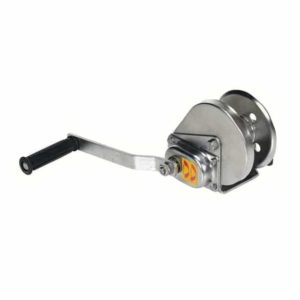
Stainless Steel Winch for the H3O and H3O+
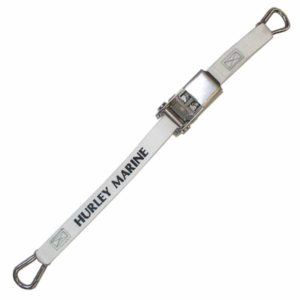
Stainless Steel Ratchet Strap

H3O Davit Extension
Hurley cleat.

Boat Davits, Dinghy Davits, Yacht Cranes
UMT Marine is a lead supplier of davits/yacht cranes to the marine industry. Our cranes are entirely made in the USA and have evolved over 15 years to become the trusted choice of yacht owners, captains, brokers, service centers, and boat builders. Not only are UMT davits/yacht cranes strong, reliable and easy to use, our after sales service is a defining benefit of choosing a UMT davit. Whether maneuvering a dinghy, RIB, Jet Ski or scooter on and off a vessel, UMT cranes will make the task easy and safe.
We specialize in:
Boat cranes: Our boat cranes are designed to make boat handling easy to load and unload cargoes in a marine environment. Our cranes are durable and reliable solutions that are used exclusively in the marine and offshore industry.
Dinghy lift: All UMT dinghy davits are excellent solutions to maneuver a dinghy or similar watercraft proficiently. Ensure hassle free dinghy handling with our products.
Jet Ski davit: The Jet Ski davit is used exclusively for personal purposes. You can use them to efficiently lift your Jet Ski out of water or for drying.
Consult with UMT and discover a new standard of excellence with boat davits for every purpose. Indeed, we would recommend that try UMT marine products for optimal benefit and we ensure that you come here for more!
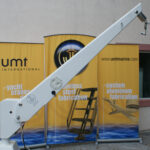
Econo Davit
ECO 600 / 800 / 1000
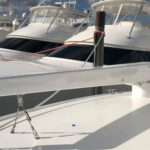
Hurricane Davit
H 1000 / 1200 / 1500 / 1800

UMT’s VX crane is the most robust and versatile yacht crane in the market.
- BOAT OF THE YEAR
- Newsletters
- Sailboat Reviews
- Boating Safety
- Sails and Rigging
- Maintenance
- Sailing Totem
- Sailor & Galley
- Living Aboard
- Destinations
- Gear & Electronics
- Charter Resources
- Ultimate Boat Giveaway

Dinghy Storage on a Sailboat
- By Dan Spurr
- Updated: August 28, 2020
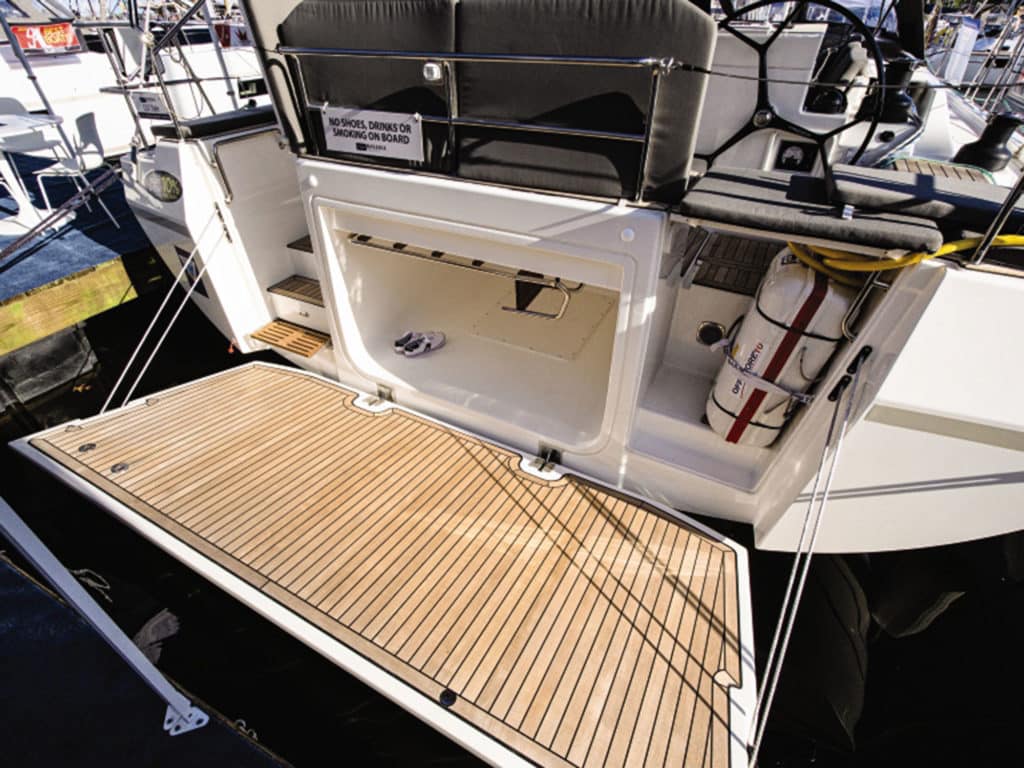
During this past October’s Boat of the Year competition at the US Sailboat Show in Annapolis, Maryland, the judges became quite familiar with the concept of “garages.” That is, a large stowage area under the cockpit for dinghies as long as 10-plus feet, as well as hard-bottomed RIBs with sizable outboard motors, and even consoles. They are accessed by fold-down doors or transoms that double as swim or launch platforms. During our evening deliberations, we three BOTY judges —Ralph Naranjo, Ed Sherman and me, along with CW editors Mark Pillsbury and Herb McCormick—began to speculate what other developments in carrying dinghies might have emerged alongside this particular innovation.
At the risk of being anticlimactic, the best answer is: none.
The other options, beyond the garage, are familiar, but there is not one unanimous choice that suits all sailboats. The decision tree begins with the mothership, and the best choice is dictated mostly by its size and design. So if you haven’t bought your cruising sailboat yet, eye each candidate with its suitability for carrying the dinghy . But if you’re committed to your current boat, you’ll have to make do.
This maneuver is OK for sheltered waters but not advisable in rough conditions, even on coastal forays. There must be a provision for securing the dinghy out of the water. If it fills with water, you might have to cut it loose before it endangers your boat. Losing a dinghy is painful.
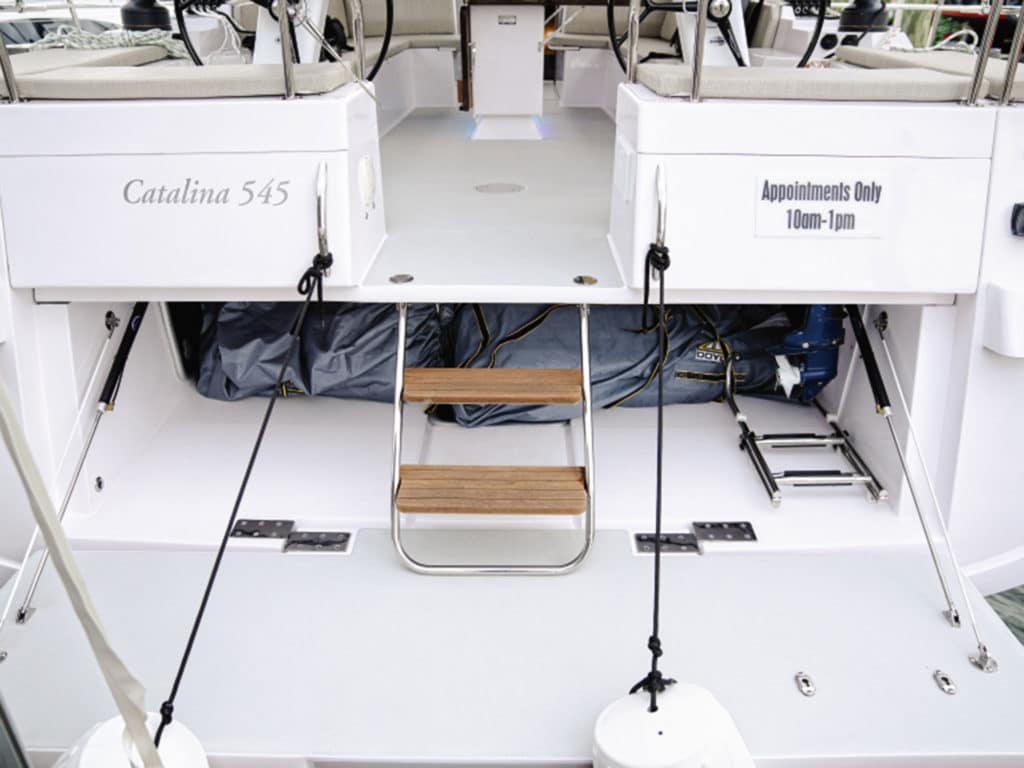
Select the painter wisely. While it would be ideal if it floated, common polypropylene quickly degrades in the sun. Three-strand or braided nylon is strong and durable. Beyond capsize or filling with spray or rainwater, a third risk is having the painter foul the propeller. Years ago, while entering Chesapeake City harbor, we ran aground. Instinctively I threw the transmission into reverse and turned to wave off the boats following us. Minutes later, while looking for alternative places to anchor, I noticed that the dinghy was gone. We expected to find it adrift, but no such luck. Then we saw it, totally submerged half under the boat. Yep, the painter fouled the prop, which yanked it underwater. What an idiot! Worse, the dinghy’s bow eye smacked a prop blade, bending it badly. The lesson? Shorten the painter for tight maneuvers.
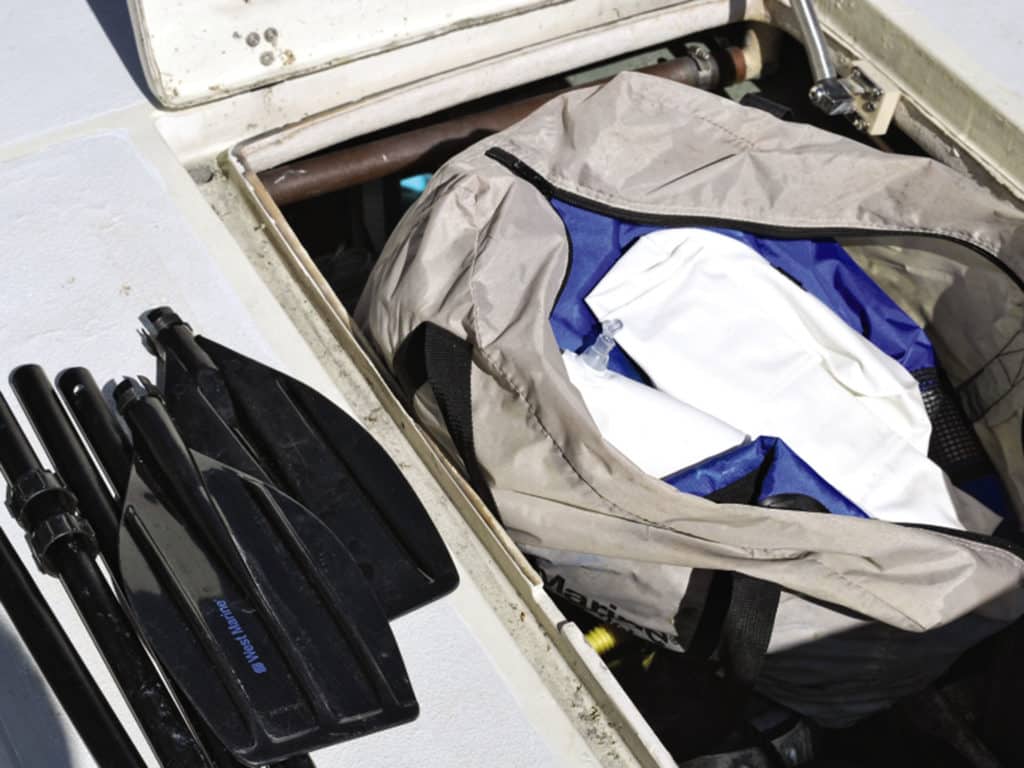
If your tender is inflatable, it might be possible to deflate it to stow in a locker (this rules out RIBs, whose fiberglass or aluminum hulls won’t fit in the lockers of most boats). The one-time commodore of the Ida Lewis Yacht Club in Newport, Rhode Island, to which I once belonged, did this on his Wanderer III replica/sistership.
During one club cruise, upon arrival at an anchorage, I watched from our boat as he retrieved his deflated dinghy from a seat locker, laid it out in the cockpit, and began to inflate it with the familiar foot pump. It took perhaps 10 minutes or so. A 12-volt electric pump would’ve sped up the process. When finished, he tossed it over the side, secured the painter, helped his wife board, and then rowed ashore.
Granted, range in such a dinky dink is severely limited; this skipper eschewed even a small outboard, and inflatables do not row well. But in the right location, it is a means of getting ashore.
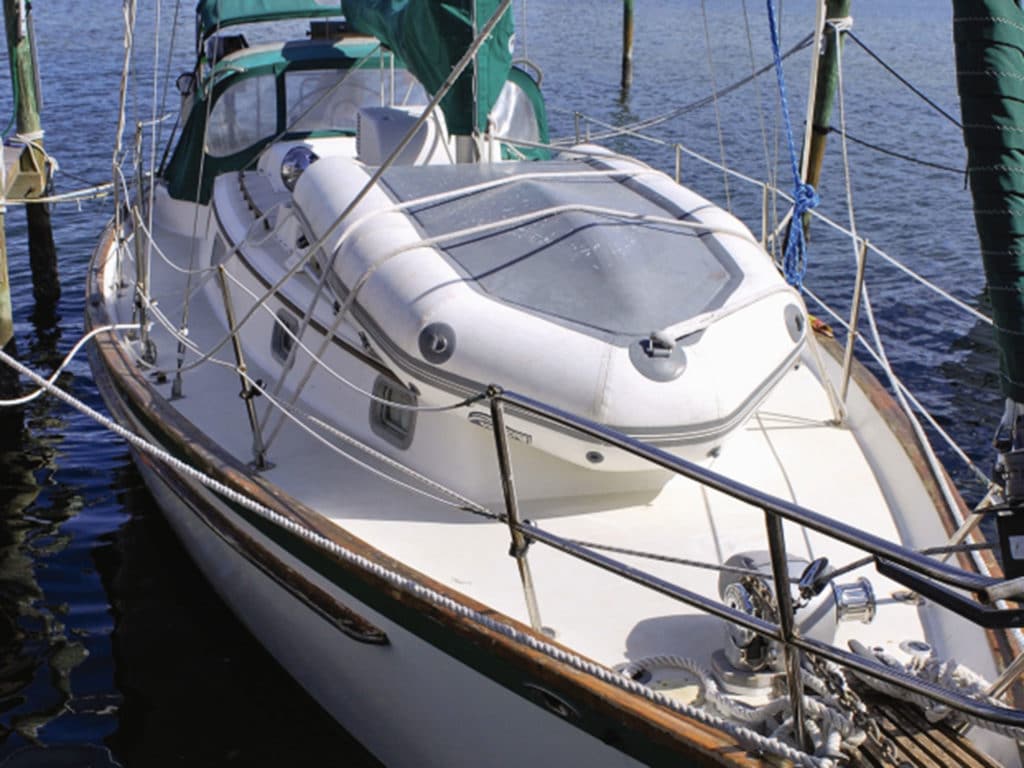
Lashing down a dinghy on deck has long been a go-to option on many cruising boats. It’s dependent on having adequate space available between the mast and cockpit enclosure (dodger or windshield) or between the mast and foredeck. The latter is less preferred, and both require that sail- and boat-handling functions, such as reefing and anchoring, are not compromised.
In this instance, you need to figure out a means of deploying and retrieving the dinghy beyond picking it up with brute strength and flinging it over the side. A four-point bridle with a lift point at the center of gravity enables lifting more or less horizontally. For mechanical advantage, a halyard led to the lift point on one end and to a mast winch at the other will generally get the job done; the main difficulty is pushing the dinghy outboard over the water. A helper on the side deck, perhaps aided by a boat hook, will make the job easier and hopefully avoid a messy situation.
Minutes later, we noticed the dinghy was gone. Yep, the painter fouled the prop, which dragged it underwater.
The dinghy can be secured by multiple wraps of line to handrails port and starboard. Tighten well or use ratchet straps. Oars can be tied in as part of this package, along with an outboard motor set on the familiar rail mount. If it’s too heavy to hand down to a waiting dinghy in the water, consider an outboard-motor lift installed at the stern that employs a block and tackle to safely lower and raise the outboard off and onto its adjacent mount.
Ah, davits. While davit hardware is somewhat expensive, this is a good option for coastal cruising. It is much safer than towing, and compared with lashing on deck, greatly simplifies launching and retrieval. If the boat has a swim platform, as more modern boats now do, it also simplifies getting in and out of the dinghy. Climbing down a transom ladder works too. And it’s usually OK to keep the outboard mounted on the tender’s transom, avoiding the often-tense business of lowering the motor from the deck to the dinghy.
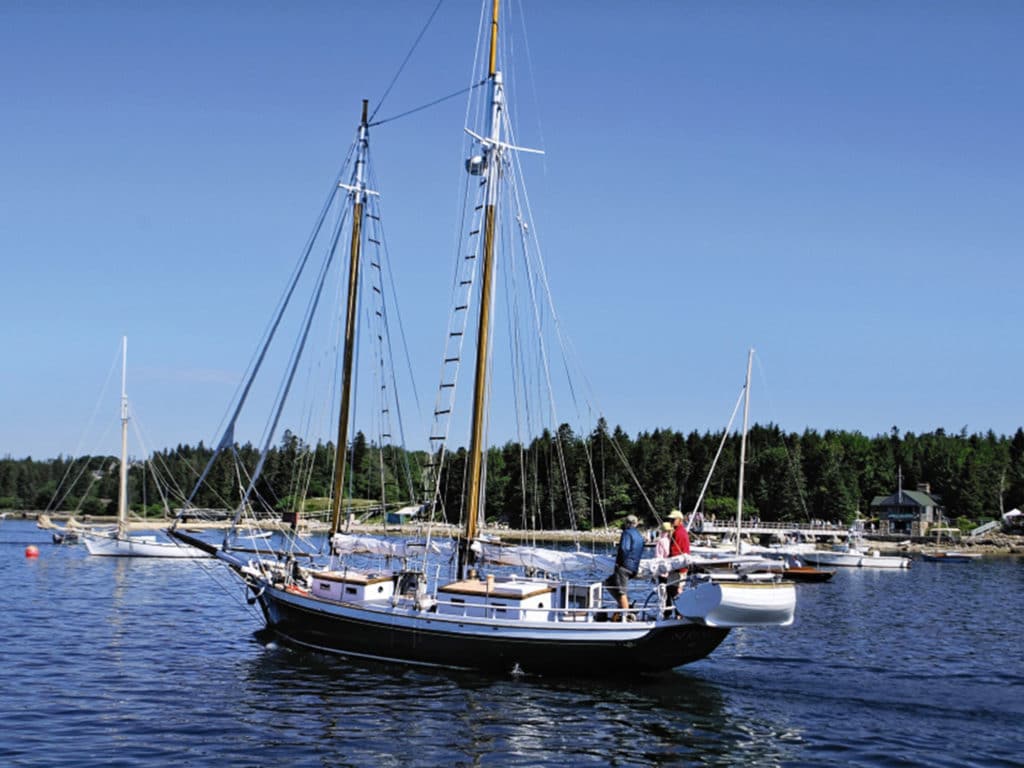
However, large breaking seas could rip off the dinghy and mangle the apparatus, possibly jeopardizing the big boat. And when docking, remember you’ve got baggage back there and don’t want to snag it on something, or bash a piling or other boat.
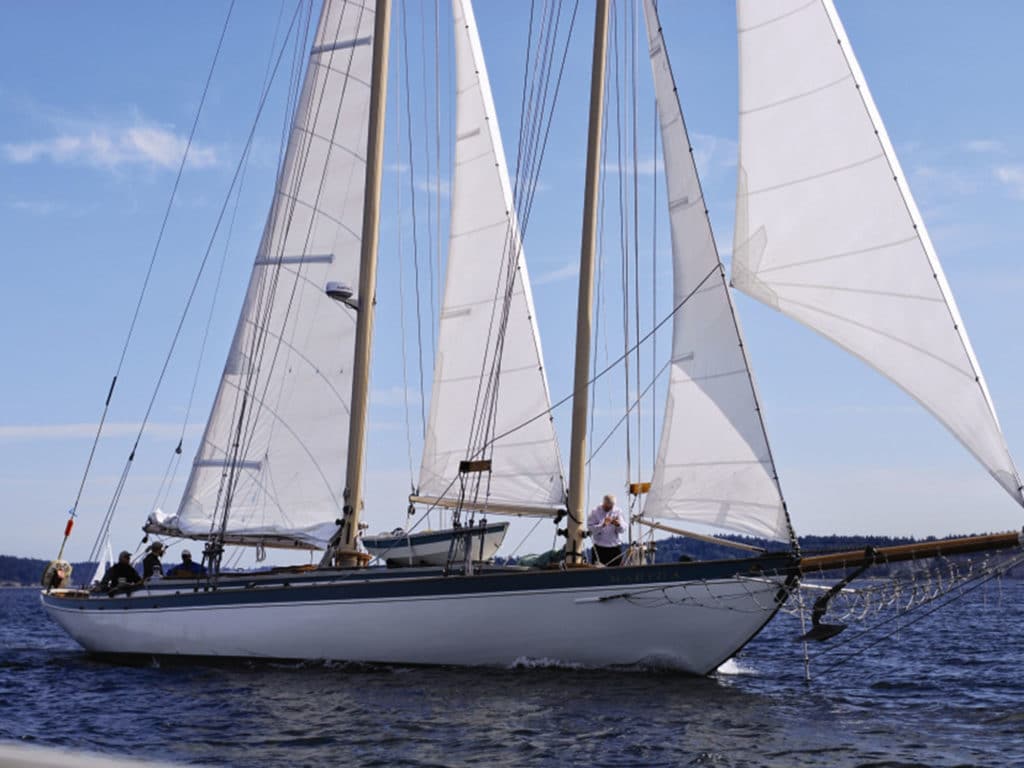
There is variety in the design of sailboat davits; for heavy loads, they mount on the afterdeck or transom, well reinforced below. With loads up to around 350 pounds, there are systems that can be mounted on a sturdy stern rail, and even kits to reinforce the stern rail.
Some large traditional sailboats, such as schooners and windjammers, carry a shore launch in davits above the midship deck, but this won’t be a viable solution for most cruising sailboats.
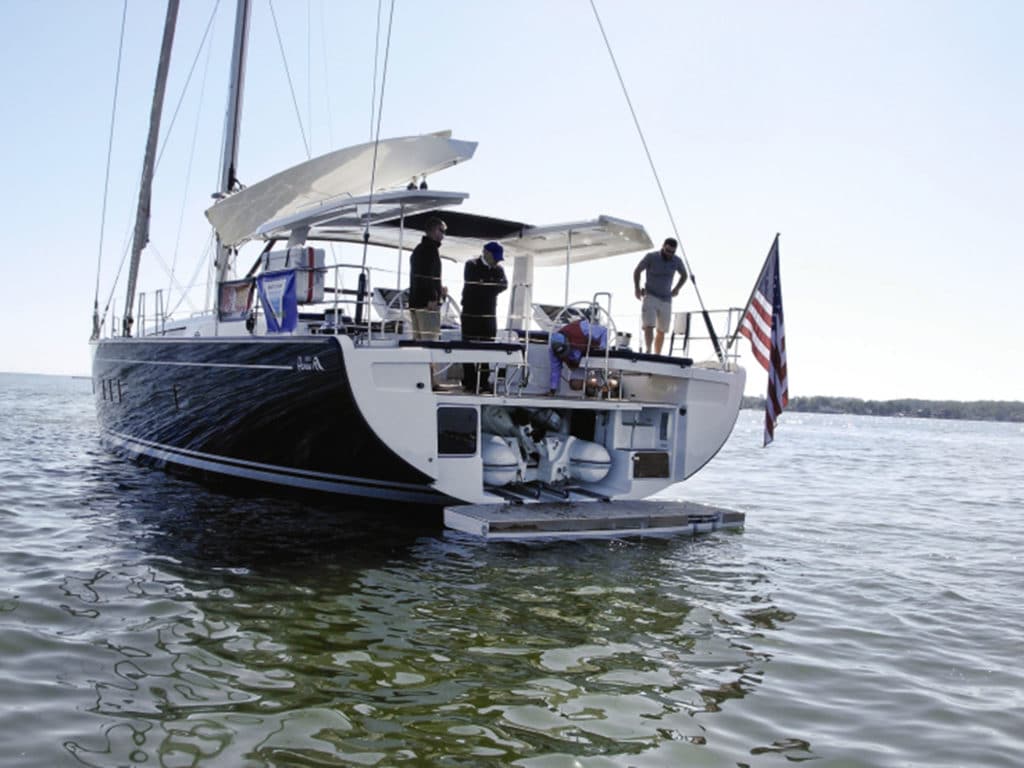
We’re back where we started, with the dinghy garage that was so popular in the 2020 BOTY competition. With so many larger boats carrying max beam aft to the transom, some designers and builders are incorporating the so-called garage for even fairly large RIBs with steering consoles under the cockpit floor, as mentioned. This is probably the safest, most secure way to carry a dinghy. Big boats such as the Hanse 675 and others employed garages with a variety of enclosure systems, most hydraulically activated. Sliding cradles that facilitate launching and retrieval with handheld controllers mean you don’t have to risk slipping a disc trying to grunt the beast aboard. Pretty slick! This isn’t something you could retrofit to an older design, but if you’re in the market for a new boat, it’s a feature well worth investigating.
Yachting journalist Dan Spurr has stowed dinghies on a long line of cruising boats he’s owned, ranging from a 28-foot Pearson Triton to a powerful Tartan 44.
- More: dinghy , How To , print aug sept 2020 , tender
- More How To

Grease the Wheels of Your Boat: A Guide to Proper Lubrication

A Bowsprit Reborn: A DIY Renovation Story

Rigging Redo: Our Switch to Synthetic

Top Tools for Sailboat Cruising: Must-Have Gear for 2024

From Paradise to Medical Emergency: A Bahamas Nightmare Turns Lesson Learned

Free Medical Advice: The Unwarranted, Unprofessional Edition

Gatekeepers of the Waterway

- Digital Edition
- Customer Service
- Privacy Policy
- Terms of Use
- Email Newsletters
- Cruising World
- Sailing World
- Salt Water Sportsman
- Sport Fishing
- Wakeboarding

- Forums New posts Unanswered threads Register Top Posts Email
- What's new New posts New Posts (legacy) Latest activity New media
- Media New media New comments
- Boat Info Downloads Weekly Quiz Topic FAQ 10000boatnames.com
- Classifieds Sell Your Boat Used Gear for Sale
- Parts General Marine Parts Hunter Beneteau Catalina MacGregor Oday
- Help Terms of Use Monday Mail Subscribe Monday Mail Unsubscribe
Dinghy Davits Whats the best?
- Thread starter capi6289
- Start date Feb 13, 2014
- Hunter Owner Forums
Hi, I just bought a Hunter 466, with a dinghy and no davits, I prefer to have it on davits and not the fore deck, I read allot about Nova Fore Spar, but they have weight limits of 300 LBS my dingy weighs 225LBS with outboard 335 lbs, what davits are recommended to support the weight and avoid swinging with healing, or weather issue. Bill
Stu Jackson
Other things to consider; Will all the crew be able to see aft with the dingy on the davits. While I can see over (6 ft) the 5 ft first mate sees the dingy and sky. Will it cover the stern light? This will require moving the stern light. Will that make your boat longer "in the slip"? Marinas usually charge by the foot of room you take up and not the actual boat length. How will you use the walk through with the dingy on the davits? Davits are not that hard to make BTW
ben solomon
Bob 04 H260
The above points are all things to consider when getting davits. We had our davits made by Ocean Marine Systems and are very pleased with the results. They custom build them for the model of Hunter you own, the size and weight of your dinghy and motor, if you want solar panels etc.. We have a 6:1 tackle on the transom end of the dinghy for the motor and only need a 4:1 for the bow. They supplied the davits to the Hunter factory after consulting with Hunter on each new model, so you can be sure they will not damage the stern rail on your boat. We can still use the swim platform, open lockers etc. with dinghy hauled up. In our case the dingy is mostly over the swim platform and have never been charged additional for a slip. They fold in when not in use or boat is hauled. Bob (no connection, just a very satisfied customer)
Attachments

RHUMB RUNNER
I would check out St Croix, the blocks our built in the end of the davit so when you are pulling up you don't get a twist in the block. They have two sizes for different load requirements. They will help you with the proper way to mount them or custom make you a mount.
capi6289 said: Hi, I just bought a Hunter 466, with a dinghy and no davits, I prefer to have it on davits and not the fore deck, I read allot about Nova Fore Spar, but they have weight limits of 300 LBS my dingy weighs 225LBS with outboard 335 lbs, what davits are recommended to support the weight and avoid swinging with healing, or weather issue. Bill Click to expand
I also have an Ocean System on my Hunter 410 (2000) and have been very satisfied. I have a walk through transom and can still get into the water going under the dinghy on the stern platform. I'm also retrieve items from the two stern lockers as well.

artboas said: Well, this wasn't a trivial project. It took the better part of last summer to perfect it. I wanted together best possible set of Davits for a 49, and here is what I came up with. There are built in winches with dynema line. Approximately 10:1 ratio on them, and you can crank up the dinghy with minimal effort. You can definitely haul up a dinghy with outboard on these, and not worry about rigidity. FYI, I stiffened up the stern with internal 3/8" glass. For an initial test, I put someone in a bosun's chair, and cranked them up from the water surface. Literally two fingers on the winch for cranking 150 pounds was all it took. Fantastically successful project View attachment 72554 Click to expand

Happy Together
artboas said: Last photo was grainy, Here's a better one <img src="http://forums.sbo.sailboatowners.com/attachment.php?attachmentid=72555"/> Click to expand
Happy Together said: Art I am jealous of your Davits. Mine are ocean marine and work Well and I lift my AB 9 VL with 2 stroke 15 hp the only problem is in big waves the boat is hard to secure to avoid the stress and strain of movement. Do you crank yours to the point where the boat is firm against the bottom side if the davit? Click to expand
Scott NIelsen
ben solomon said: I have davits on my 37.5 legend. Because of leverage and weight limits, my davits put the dinghy about 3 feet off the cockpit floor. I makes for a nice outdoor storage area . If it's a short trip, i keep the engine on the dinghy. Longer trips, engine on the rail. I inherited these from the PO. One suggestion.....if you are going to have new davits made, consider future needs like solar panel mounts and/or wind generator mounts so you won't have to go back and retro fit. Ben Click to expand
Sure I can. Next time I go to the boat, I will take some photos. I have a few sailing vids that you can see the dinghy on the davits if you would like that in the meantime. They are on youtube. Ben
I don't know what are Best. All I can say is that I have St Criox rotating ones and I don't like them (but my money is spent so am going to live with them)
Don Lucas said: I don't know what are Best. All I can say is that I have St Criox rotating ones and I don't like them (but my money is spent so am going to live with them) Click to expand
When my Beneteau Oceanis 37 arrives it will be outfitted with Kato Marine "Voyager" Davits. Each arm is capable of lifting 420 lbs. http://www.katomarine.com/saildavits-voyager.htm They would be great on your size Hunter. They are usually seen on the larger sailboats like yours but I want a strong davit system that is independent of the push pits. I will also mount solar panels on them.
Ocean Marine I have ocean marine davits on my 2007 H-36 that came off a 410 hunter and they are very heavy duty for sure what I like about them is the you have a option to install them so the height is so to look over and out the back with good view and my stern light is visible and access to my stern compartments also and yes can step under and out the stern and have had others come aboard while dinghy is up,I have double stainless bar to stop swinging and can secure dinghy with straps or line to secure it against the arms and double bar. I have 9'6'' with aluminum floor and 8hp motor and usualyy sail and motor with motor on dinghy and as I said I can pull up against the arms and double cross bar with line and the dinghy stays nice with out swinging all over. I think it is a very well built system with arms that extend out to keep dinghy out a way from stern and not to fold up if needed. Nick
seadaddler said: I have ocean marine davits on my 2007 H-36 that came off a 410 hunter and they are very heavy duty for sure what I like about them is the you have a option to install them so the height is so to look over and out the back with good view and my stern light is visible and access to my stern compartments also and yes can step under and out the stern and have had others come aboard while dinghy is up,I have double stainless bar to stop swinging and can secure dinghy with straps or line to secure it against the arms and double bar. I have 9'6'' with aluminum floor and 8hp motor and usualyy sail and motor with motor on dinghy and as I said I can pull up against the arms and double cross bar with line and the dinghy stays nice with out swinging all over. I think it is a very well built system with arms that extend out to keep dinghy out a way from stern and not to fold up if needed. Nick Click to expand
- This site uses cookies to help personalise content, tailor your experience and to keep you logged in if you register. By continuing to use this site, you are consenting to our use of cookies. Accept Learn more…
Visit our Popular Forums
- Monohull Sailboats
- Multihull Sailboats
- Powered Boats
- General Sailing
- Antares Yachts
- Fountaine Pajot
- Lagoon Catamarans
Cruising Business
- Boat Classifieds
- General Classifieds
- Crew Positions
- Commercial Posts
- Vendor Spotlight
Life Aboard a Boat
- Provisioning: Food & Drink
- Families, Kids, & Pets Afloat
- Recreation, Entertainment, & Fun
- Boat Ownership & Making a Living
- Liveaboard's Forum
Seamanship, Navigation & Boat Handling
- Seamanship & Boat Handling
- Training, Licensing, & Certification
- Health, Safety, & Related Gear
- Rules of the Road, Regulations, & Red Tape
Engineering & Systems
- Const. / Maint. / Refit
- Product / Service Reviews
- Electronics: Comms / AV
- Electrical: Batts / Gen / Solar
- Lithium Power Systems
- Engines & Propulsion
- Propellers & Drive Systems
- Plumbing / Fixtures
- Deck Hdw: Rigging / Sails
- Aux. Equipment & Dinghy
- Anchoring & Mooring
Photo Categories
- Member Galleries
- Life Onboard
- Sailing in the Wind
- Power Boats
- Cruising Destinations
- Maint. & Boat Building
- Marine Life
- Scuba Diving & Divers
- General Photos
Recent Photos

Listing Categories
- African Cats
- view more »
- Crew Wanted
- Crew Available
- Enhance Your Account
- Meet the Mods
- Meet the Advisors
- Signup for The Daily Cruiser Email

COMMENTS
MarTek Davits provides Dinghy Davits, Engine Hoists, Solar Panel Mounts and other quality products for sailboats, catamarans, and cruisers
Dinghy Davits on Catamarans (why you need them) You don't actually need dinghy davits but having properly engineered davits on your catamaran can make your life much more convenient and save you lots of headaches and money. You don't absolutely need dinghy davits on a catamaran or sailboat.
Discover the high-quality construction of MarTek Dinghy Davits. Constructed with 316 stainless steel tubing and precision-welded joints.
DIY: Installing Davits. Davits are a good way to keep the dinghy safe and ready to use on short notice. After many hours of discussion, my wife, Vicki, and I decided to install a set of davits on Freelance, our Pearson 36 cutter. We hoped davits would solve our dinghy storage problem and save us time getting the dinghy in the water.
When a boat is large enough for even the occasional overnight, the need for a dinghy becomes almost mandatory. But where do you put that all-important link to shore for lunch, dinner, shopping for supplies, walking the dog, seeing the sights, exploring the shoreline, or visiting neighboring boats? Fortunately, when it comes to davits, we have many choices to suit needs and budgets. Considering ...
Davits and arches : Getting your dinghy back aboard your multihull The dinghy is the one piece of equipment you use at every port of call, meaning 70% of the time while you're cruising. But what about launching it and getting it back on board? We take a look at the systems available.
We offer high-quality, high-performance boat davits at very competitive prices. Dinghy Davit for your yacht, carry your dinghy or Sea-Doo Spark with ease. IN STOCK. Models: Top mount Davits, Extended Davits, Lift davits, Drop Down Davits.
Versatile mounting designs ensure a perfect fit with offshore strength standard. When not in use, davits fold inward to stow flush with boat's stern. Nova Lifts come standard with 1" rail mounting brackets; optional 1-1/4" brackets are available. Double sheave head is built for increased strength. Davit fits rails from 23" to 32" high.
Welcome to Ocean Marine Systems. We produce high quality marine stainless steel precision welded Davit systems. We are proud of the world-wide record of performance that our dinghy davit systems deliver year after year as well as our outstanding record of product engineering, quality, technical support, customer service and the "beyond the ...
Boat Davits & Dinghy Lifts at Fisheries Supply Fisheries Supply offers an exceptional range of davit systems, expertly crafted by renowned manufacturers like Forespar and Weaver. These systems are designed to efficiently lift and launch dinghies, jet skis, and tenders, making them an essential addition for both sailboats and powerboats.
Kato Marine has four models of sailboat davits: BayII model - Stainless steel. Generally for smaller boats and lighter dinghies, roughly 27' to 35' boats, or dinghies around 8' - 10' and light. Island model - Stainless steel. Handles larger dinghies, typically up to around 11.5' and fifteen HP outboards. Winch model - Stainless steel. Same design as the Island model, but with a ...
The Hurley H3O Dinghy Davit System ® is specifically designed to allow the safe retrieval and stowage of a rib dinghy / hard-hulled tender, using the linear bunk system for on your boat or dock. The H3O Dinghy Davit ® has an adjustable and removable winching system. The stainless steel retrieval arm is adjustable from 3' to 5', depending upon ...
Boat Davits, Dinghy Davits, Yacht Cranes UMT Marine is a lead supplier of davits/yacht cranes to the marine industry. Our cranes are entirely made in the USA and have evolved over 15 years to become the trusted choice of yacht owners, captains, brokers, service centers, and boat builders.
Some large traditional sailboats, such as schooners and windjammers, carry a shore launch in davits above the midship deck, but this won't be a viable solution for most cruising sailboats.
Feb 13, 2014. #2. There is no "best" or at least rarely is in boating. There are compromises, like removing your dinghy engine, to lighten the load. Kato and Garhauer also make davits. A Google search may turn up a few more. Garhauer has a good reputation for relatively inexpensive but great & strong gear.
We have to improve the way we carry our dinghy on our sailboat, 9 LIVES. So, we ordered a custom-built aluminum arch from Nautical Creations in Kentucky and added some very simple davits made from ...
Hello, having just moved on to a catamaran , I am trying to solve the issue of how to secure the dinghy hanging on the davits . I have got three cables holding the dinghy to the arch and solid bar
Rent a Power catamaran in Perm Krai for a fantastic price ⛵ Choose among thousands of charter yachts available online and save money Summer 2021 - over 651 exclusive deals online Best prices - save on average 784 € on each booking
Yacht Charter in Perm Krai Charter a yacht and explore Perm Krai! Prices start from 8 € per day. Choose from the largest selection of sailboats, catamarans, motor boats, motor yachts, houseboats, gulets and power catamarans. Popular cities are .
This HD live webcam takes you to the city Solikamsk in the Russian Perm Krai. The online stream shows you the intersection of the major street Severnaya and Molodezhnaya street, including the local time and weather in Solikamsk. This city is one of the oldest towns in the Krai, with a rich heritage seen in many historical buildings such as the governor's house, the oldest civil building in the ...
This HD webcam at the Krylova Perm Zhk Danilikha Condominium complex shows the cityscape of Dzerzhinsky City District in Perm, western Russia, while listening to music via this live stream. Perm is the sixth-largest city in Russia, with a population of about 1.2 million peo...